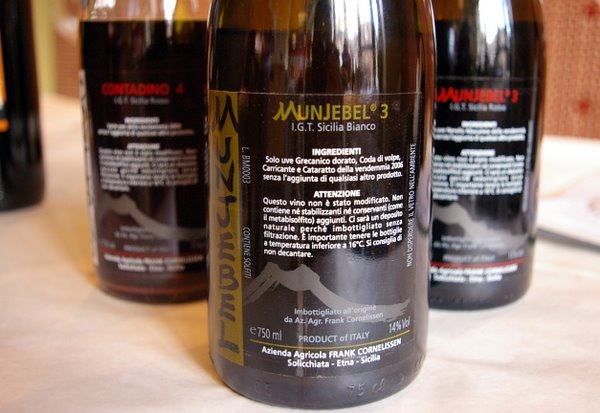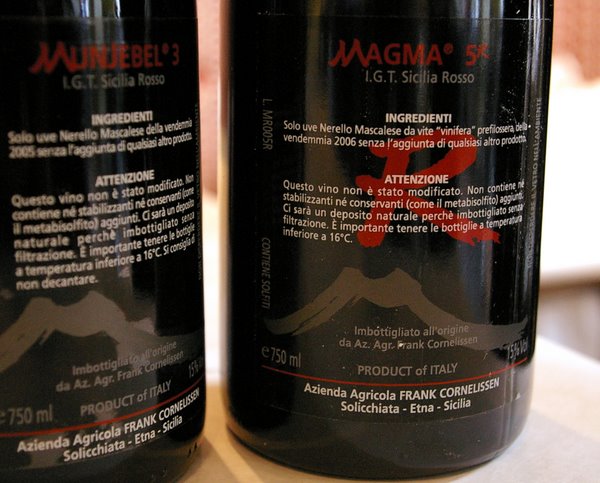|
Revisiting
the natural wines of Frank Cornelisson, from
Sicily's Mount Etna
Website:
www.frankcornelissen.it
UK
agent: David Harvey, Sous l'Nez, Soloman's Yard, 2a Brenthouse Road,
London E9 6QG, Tel:
+44 (0)7977 939680, soulnez@googlemail.com

I’ve
written before about the remarkable wines made by Frank Cornelissen in
Sicily’s upcoming wine region of Mount Etna (read this
write-up, now a few years old, for the full background).
Cornelissen takes naturalness to an extreme, but his wines are utterly
compelling. Here’s how he explains the underlying motivation for his
hands-off approach:
“Our
farming philosophy is based on our acceptance of the fact that man
will never be able to understand nature's full complexity and
interactions. We therefore choose to concentrate on observing and
learning the movements of Mother Earth in her various energetic and
cosmic passages and prefer to follow her indications as to what to do,
instead of deciding ourselves. Consequently this has taken us to
avoiding all possible interventions on the land we cultivate,
including any treatments, whether chemical, organic, or biodynamic, as
these are all a mere reflection of the inability of man to accept
nature as she is and will be. “
Frank’s
viticultural approach is the most extreme of all. He avoids any sorts
of spraying, including the sulfur and copper remedies used by organic
and biodynamic growers. He’s managed to do this even in difficult
vintages such as 2004 and 2005, although 2002 and 2003 were so
difficult that some treatments were needed to save the crop. The
estate is 12 hectares, with 8.5 hectares of vineyards. The vines are
free standing bush vines (known here as alberello; in France this is
referred to as gobelet). The rest of the estate consists of olive,
fruit and nut trees as well as brush. Frank doesn’t like the idea of
monoculture, so interplants the vines with various local fruits and
wheat. He planted a new vineyard a few years ago with ungrafted
cuttings from existing old vines on the estate, and these vines were
planted at lower density to allow cultivation of other plants between
the vines. Yields are tiny, averaging 300 g per vine. The vines are
manicured, with great attention being taken to ensure the grapes are
healthy, and a long, late harvest consisting of multiple passes
through the vineyard in late October to mid November.
Winemaking
is crazy, but it works. Depending on the wine, fermentation takes
place either in plastic tanks outside, or terracotta amphorae (known
as giarre) buried up to their necks in crushed volcanic rock. Either
way, both reds and whites have a long maceration on skins. ‘The
skins, seeds and nascent wine remain unseparated during the entire
transformation, maintaining a cosmic link, and enabling extraction of
all possible aromas of soil and territory,’ says Frank. After
fermentation, the wines are basket pressed and are then returned to
amphorae for a long
maturation.
No
additions at all are made during the winemaking process. Because no SO2 is added, Frank advises keeping the wine below 16 °C
during transport and storage, and not decanting it.
Frank
also has a ‘social’ pricing structure. Paradoxically, adding
nothing to the vineyard or during the winemaking process costs a lot
of money. This means that the wines are quite expensive. Initially
MunJebel, the second label, was a bit too expensive, so Frank made it
cheaper and increased the price of the top wine, Magma. The third wine
in the stable is the Rosso
del Contadino, which is more affordable, but still delicious. It’s a
field blend of white and red varieties including Carricante, Inzolia,
Catarratto, Nerello Mascalese, Alicante and Nerello Cappuccio. It’s
a cloudy wine, because it is bottled after the 'noble lees' in the
amphora are stirred.

Rosso
del Contadino No 4 (2006)
15% alcohol. Beautifully pure, focused sweet red fruits nose is
alluring and almost impossibly complex, with notes of spice, herbs,
leather, earth and tea. The palate is complex and spicy with amazing
presence in the mouth. Spicy and earthy, with elegant textured fruit
and a dry finish. Amazing stuff, and incredible considering that this
is Frank’s cheapest wine! 95/100
Rosso
del Contadino No 5 (2007 vintage)
Fresh, focused cherry fruit nose with some spiciness. Elegant and
a bit sappy. The palate is smooth, elegant and fresh with some supple
red fruits. A lovely fresh style. 91/100
MunJebel
Bianco No 3 (2006)
This wine used to be called Mongibello, but with this vintage
changed its name to Munjebel. It’s a blend of Grecanico Dorato, Coda
di Volpe, Carricante and Cattaratto. Cloudy yellow colour. Amazingly
sweet aromatic nose with complex notes of tangerine, herb, vanilla and
spice. The palate is quite savoury with lovely complexity, high
acidity and tannin, yet also delicious warmth and sweetness of fruit.
Amazing length. A remarkable wine. 94/100
MunJebel
Bianco No 4 (2007)
Cloudy orange colour. Fantastic nose: tight and herby with orange
and spice characters. Quite sweet but complex. The palate is tight
with some structure and nice herbiness as well as sweet fruit. Lovely.
92/100
MunJebel
Rosso No 3 (2006)
Varietal Nerello Mascalese; 15% alcohol. Brooding sweet earthy fruit on the nose
with some tea notes. The dense palate has lovely freshness as well as
bold, sweet fruit. There’s structure here, and it finishes quite
tight. A bold earthy style. 93/100
MunJebel
Rosso No 4 (2006/7)
Pale colour. Fresh, bright fruit on the nose with sweet cherries
to the fore. Baked cherry pie character. The palate is smooth and
elegant with lovely earthy spiciness and great complexity. Finishes
earthy and tannic. 93/100
Magma
R No 5 (2006)
This is Frank’s top wine. Complex earthy, spicy nose. Brooding
with lifted notes of plum and spice, wood and earth, and a hint of
raisins. The palate is sweet, a bit like a tawny port, with lovely
spicy, earthy structure. Elegant with an almost eternal finish.
Tremendously complex. 95/100
See
a more recent review of these
wines here
Wines tasted 05/08
Find
these wines with wine-searcher.com
Back to top
|

